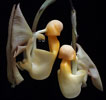|
|
|
|
|
| |
Flasks of
Coryanthes speciosa 'CC9950' × self |
|
| |
|
|
| |
| Number: |
TN3870 |
| Name: |
Coryanthes speciosa 'CC9950' × self
|
| Type: |
self (What's that?) |
|
Seed Donor: |
Troy C. Meyers
|
|
Click to Enlarge

Pod Parent Flowers |
Click to Enlarge

Offspring 'MC4741' Flowers |
| Offspring photos are siblings of the plants you would receive. |
|
|
|
| |
Culture Notes from Donor: Parent plant: Temperature range I (60-83°F)
Comments: Parent plant: Flowers have a citrus-like scent similar to lemon grass. Flowers are small, about 2-1/4 inches (6 cm) from the top of the cap to the bottom of the bucket, on a relatively long 14-inch (36 cm) stem. Medium-sized plant.
For additional origin/habitat information supplied courtesy of
Charles and Margaret Baker, see further below, near the bottom of this page.
|
Temperatures we attempt to use in the lab & greenhouse:
| For Species: |
|
Spring, Summer, Autumn, Winter: days average 82°F, nights 66°F; best fit is Warm-Intermediate 87-64°F
(Source:
Baker's Web OSC) |
|
About the name...
| Etymology of |
Coryanthes |
|
From Greek "korys" helmet; "anthos" flower.
(Source:
Pridgeon 1992) |
| Etymology of |
speciosa |
|
From Latin "speciosus" beautiful, outstanding.
(Source:
Mayr & Schmucker 1998) |
| Pronunciation of |
Coryanthes |
|
ko-ree-AN-theez
(Source:
Pridgeon 1992) |
| Pronunciation of |
speciosa |
|
spee-see-OH-sa
(Source:
Hawkes 1978) |
|
If you would like to direct someone to this web page, please copy and paste this URL into your email:
http://troymeyers.com/d?013870
| Flask Information |
| Availability: |
We have sold all of the flasks for this item. |
| You should: |
Consider getting individual plants or compots instead of a flask.
You can place a "Notify Flask Recipients" Request, and either we or a flask recipient may contact you when plants are available.
You may also place a "Notify Retries" Request, and if an identical pollination (the same parents) is done again, we'll let you know.
You may reserve a flask, but it's very unlikely you'll get one ...this could only happen if we found a flask that we didn't know we had. |
| Yield Estimate: |
600 plants (based on flask surveys done 11/04/2003 through 03/18/2004)
|
| Plantlet Sizes: |
From many flasks 1 - 120 mm plants (based on flask surveys done 12/16/2003 through 06/09/2004)
From one most recently surveyed flask 70 - 120 mm (06/09/2004)
|
|
You might also want to:
|
View the seed assay for this item.
View items of the same species.
View items of the same genus.
|
| Ordering Information |
| You are not currently logged in. |
|
You must be a registered user and be logged in to reserve a flask or place a notification request. Please log in:
|
|
|
|
|
|
| |
The origin/habitat information below is supplied courtesy of Charles and Margaret Baker
The following information is based on the name of the plant provided by the donor, and assumes that the name is correct. If the plant has been misidentified, then the following information may not be correct.
This text is copyrighted by the Bakers and may not be reproduced without permission.
ORIGIN/HABITAT: Widespread from the Yucatan Peninsula of Mexico southward
through Guatemala, Honduras, Costa Rica, Panama, Trinidad, Venezuela,
British Guiana, Brazil, Colombia, and Peru. These plants grow as epiphytes
in low-lying, hot, humid regions, usually below 3300 ft. (1000 m).
Specific habitat information was not given, but Coryanthes species are
normally found growing in very acid conditions on the nests of ants.
More about this information and the Bakers...
|
|
|
| |
|
|
|